Critical Analysis of Sydney as a TDR Using Tourism Theories
VerifiedAdded on 2023/06/12
|10
|2493
|197
Essay
AI Summary
This essay provides a comprehensive analysis of Sydney as a successful Tourist Destination Region (TDR), examining the factors that contribute to its attractiveness and the role of tourism in its economic and social development. It applies key tourism theories, including Leiper’s model and Butler’s tourism area life cycle model, to assess Sydney's strengths and weaknesses as a tourist destination. The essay also explores the impact of tourism on Sydney's infrastructure, environment, and local communities, highlighting the importance of sustainable tourism practices. Furthermore, it discusses the initiatives taken by the NSW government and other stakeholders to promote Sydney as a global tourist destination while ensuring long-term sustainability. The essay concludes that Sydney has successfully leveraged its natural beauty, cultural attractions, and strategic tourism management to become a prominent TDR, emphasizing the need for continued efforts in sustainable development to maintain its competitive edge.
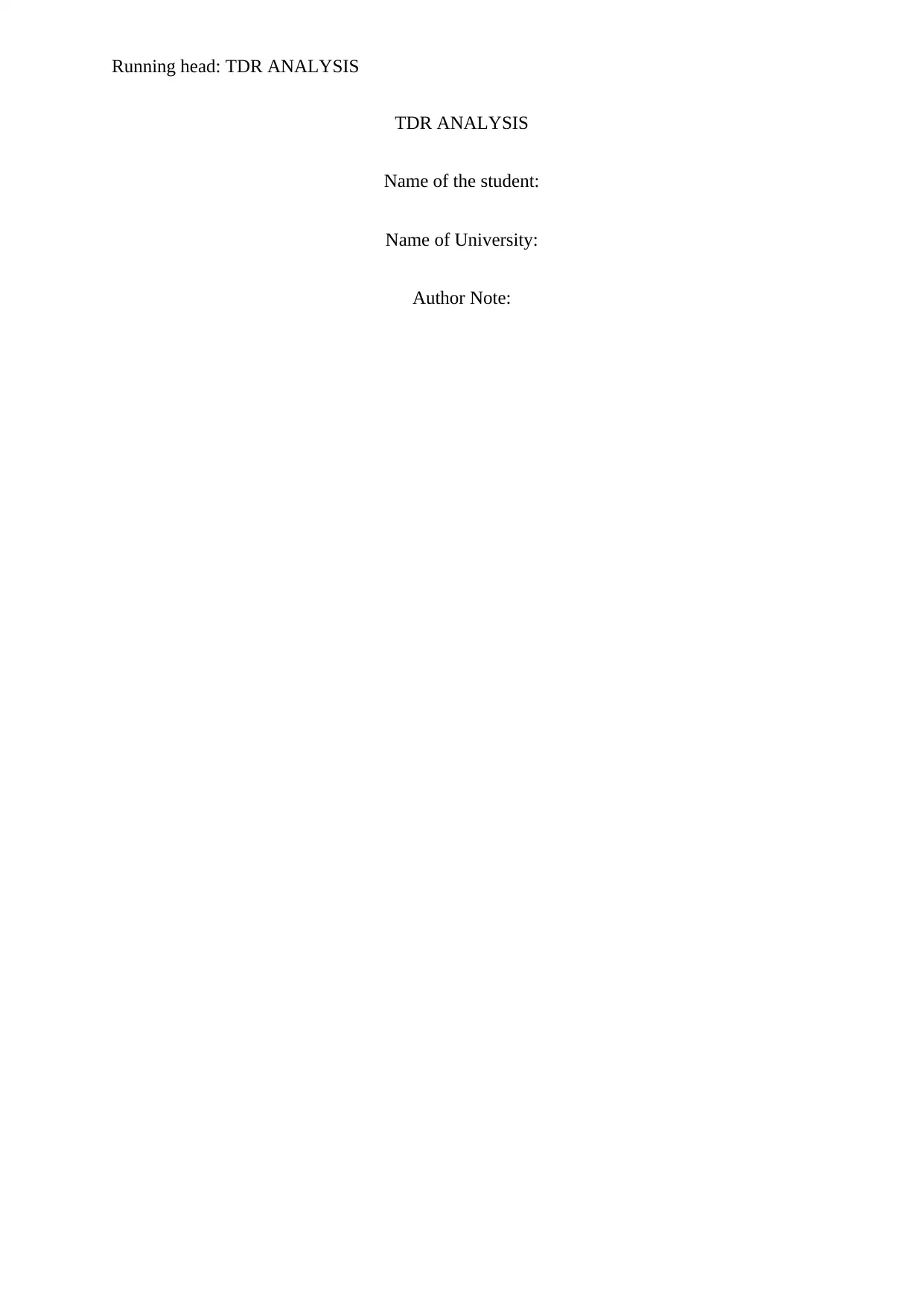
Running head: TDR ANALYSIS
TDR ANALYSIS
Name of the student:
Name of University:
Author Note:
TDR ANALYSIS
Name of the student:
Name of University:
Author Note:
Paraphrase This Document
Need a fresh take? Get an instant paraphrase of this document with our AI Paraphraser
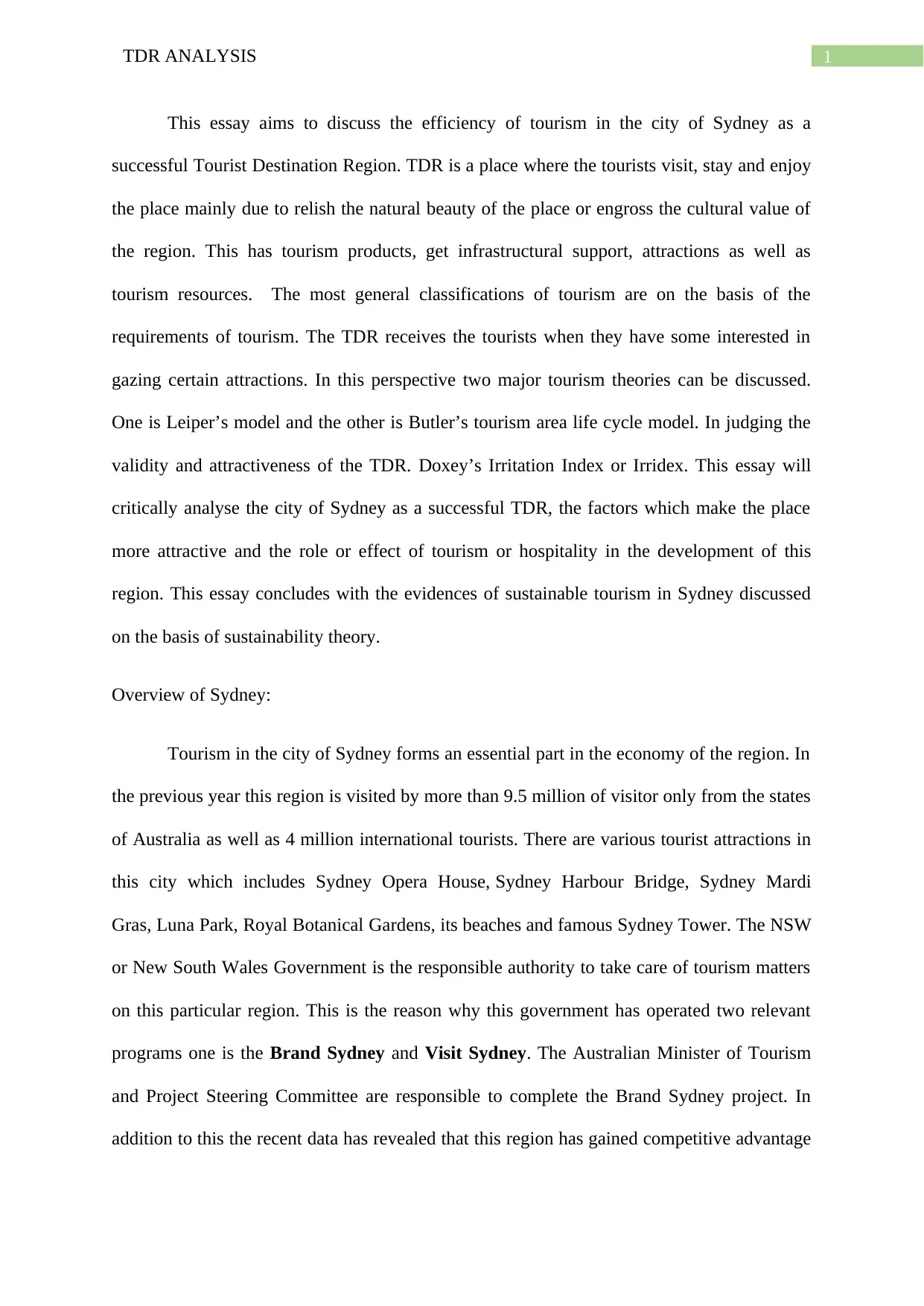
1TDR ANALYSIS
This essay aims to discuss the efficiency of tourism in the city of Sydney as a
successful Tourist Destination Region. TDR is a place where the tourists visit, stay and enjoy
the place mainly due to relish the natural beauty of the place or engross the cultural value of
the region. This has tourism products, get infrastructural support, attractions as well as
tourism resources. The most general classifications of tourism are on the basis of the
requirements of tourism. The TDR receives the tourists when they have some interested in
gazing certain attractions. In this perspective two major tourism theories can be discussed.
One is Leiper’s model and the other is Butler’s tourism area life cycle model. In judging the
validity and attractiveness of the TDR. Doxey’s Irritation Index or Irridex. This essay will
critically analyse the city of Sydney as a successful TDR, the factors which make the place
more attractive and the role or effect of tourism or hospitality in the development of this
region. This essay concludes with the evidences of sustainable tourism in Sydney discussed
on the basis of sustainability theory.
Overview of Sydney:
Tourism in the city of Sydney forms an essential part in the economy of the region. In
the previous year this region is visited by more than 9.5 million of visitor only from the states
of Australia as well as 4 million international tourists. There are various tourist attractions in
this city which includes Sydney Opera House, Sydney Harbour Bridge, Sydney Mardi
Gras, Luna Park, Royal Botanical Gardens, its beaches and famous Sydney Tower. The NSW
or New South Wales Government is the responsible authority to take care of tourism matters
on this particular region. This is the reason why this government has operated two relevant
programs one is the Brand Sydney and Visit Sydney. The Australian Minister of Tourism
and Project Steering Committee are responsible to complete the Brand Sydney project. In
addition to this the recent data has revealed that this region has gained competitive advantage
This essay aims to discuss the efficiency of tourism in the city of Sydney as a
successful Tourist Destination Region. TDR is a place where the tourists visit, stay and enjoy
the place mainly due to relish the natural beauty of the place or engross the cultural value of
the region. This has tourism products, get infrastructural support, attractions as well as
tourism resources. The most general classifications of tourism are on the basis of the
requirements of tourism. The TDR receives the tourists when they have some interested in
gazing certain attractions. In this perspective two major tourism theories can be discussed.
One is Leiper’s model and the other is Butler’s tourism area life cycle model. In judging the
validity and attractiveness of the TDR. Doxey’s Irritation Index or Irridex. This essay will
critically analyse the city of Sydney as a successful TDR, the factors which make the place
more attractive and the role or effect of tourism or hospitality in the development of this
region. This essay concludes with the evidences of sustainable tourism in Sydney discussed
on the basis of sustainability theory.
Overview of Sydney:
Tourism in the city of Sydney forms an essential part in the economy of the region. In
the previous year this region is visited by more than 9.5 million of visitor only from the states
of Australia as well as 4 million international tourists. There are various tourist attractions in
this city which includes Sydney Opera House, Sydney Harbour Bridge, Sydney Mardi
Gras, Luna Park, Royal Botanical Gardens, its beaches and famous Sydney Tower. The NSW
or New South Wales Government is the responsible authority to take care of tourism matters
on this particular region. This is the reason why this government has operated two relevant
programs one is the Brand Sydney and Visit Sydney. The Australian Minister of Tourism
and Project Steering Committee are responsible to complete the Brand Sydney project. In
addition to this the recent data has revealed that this region has gained competitive advantage
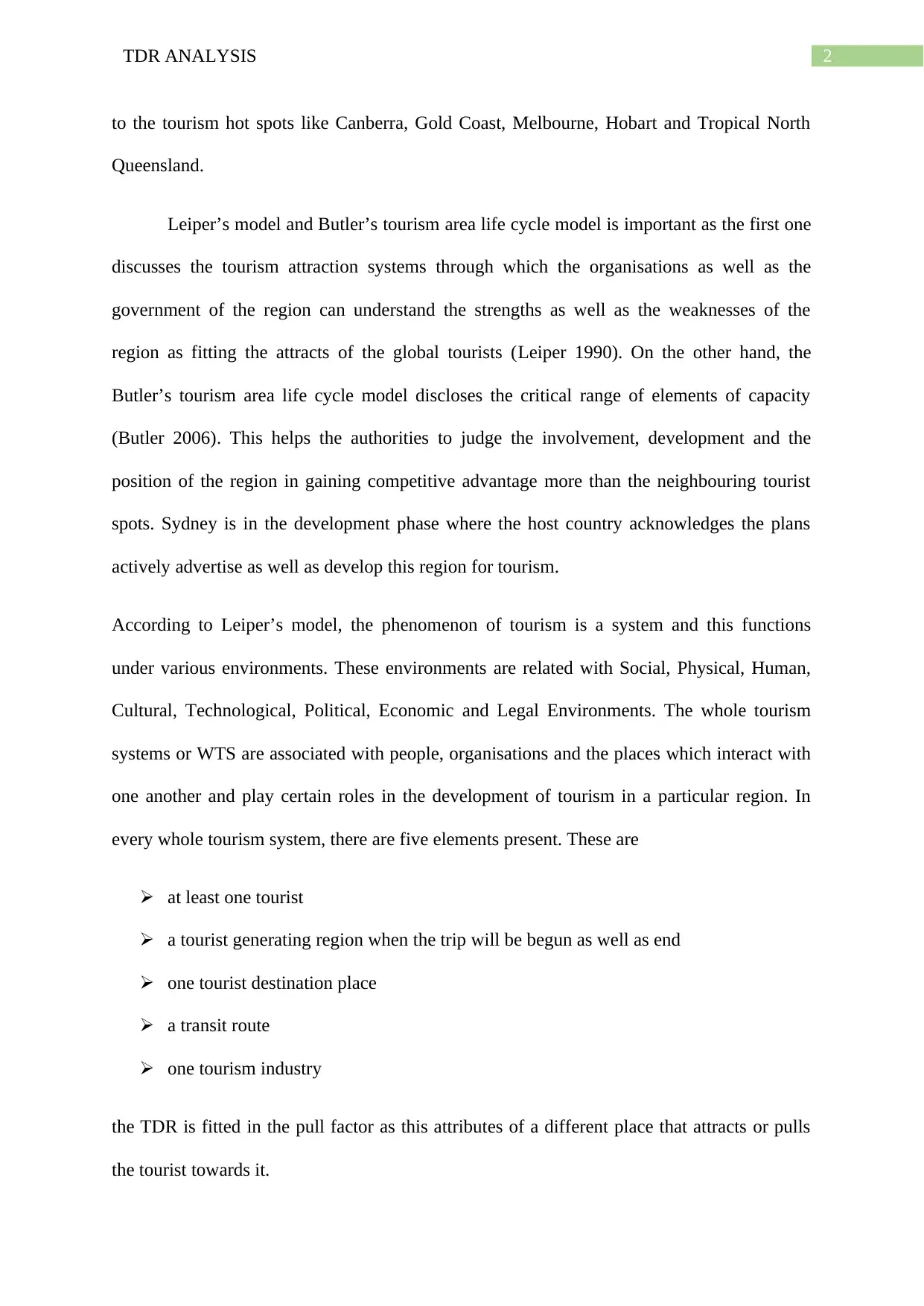
2TDR ANALYSIS
to the tourism hot spots like Canberra, Gold Coast, Melbourne, Hobart and Tropical North
Queensland.
Leiper’s model and Butler’s tourism area life cycle model is important as the first one
discusses the tourism attraction systems through which the organisations as well as the
government of the region can understand the strengths as well as the weaknesses of the
region as fitting the attracts of the global tourists (Leiper 1990). On the other hand, the
Butler’s tourism area life cycle model discloses the critical range of elements of capacity
(Butler 2006). This helps the authorities to judge the involvement, development and the
position of the region in gaining competitive advantage more than the neighbouring tourist
spots. Sydney is in the development phase where the host country acknowledges the plans
actively advertise as well as develop this region for tourism.
According to Leiper’s model, the phenomenon of tourism is a system and this functions
under various environments. These environments are related with Social, Physical, Human,
Cultural, Technological, Political, Economic and Legal Environments. The whole tourism
systems or WTS are associated with people, organisations and the places which interact with
one another and play certain roles in the development of tourism in a particular region. In
every whole tourism system, there are five elements present. These are
at least one tourist
a tourist generating region when the trip will be begun as well as end
one tourist destination place
a transit route
one tourism industry
the TDR is fitted in the pull factor as this attributes of a different place that attracts or pulls
the tourist towards it.
to the tourism hot spots like Canberra, Gold Coast, Melbourne, Hobart and Tropical North
Queensland.
Leiper’s model and Butler’s tourism area life cycle model is important as the first one
discusses the tourism attraction systems through which the organisations as well as the
government of the region can understand the strengths as well as the weaknesses of the
region as fitting the attracts of the global tourists (Leiper 1990). On the other hand, the
Butler’s tourism area life cycle model discloses the critical range of elements of capacity
(Butler 2006). This helps the authorities to judge the involvement, development and the
position of the region in gaining competitive advantage more than the neighbouring tourist
spots. Sydney is in the development phase where the host country acknowledges the plans
actively advertise as well as develop this region for tourism.
According to Leiper’s model, the phenomenon of tourism is a system and this functions
under various environments. These environments are related with Social, Physical, Human,
Cultural, Technological, Political, Economic and Legal Environments. The whole tourism
systems or WTS are associated with people, organisations and the places which interact with
one another and play certain roles in the development of tourism in a particular region. In
every whole tourism system, there are five elements present. These are
at least one tourist
a tourist generating region when the trip will be begun as well as end
one tourist destination place
a transit route
one tourism industry
the TDR is fitted in the pull factor as this attributes of a different place that attracts or pulls
the tourist towards it.
⊘ This is a preview!⊘
Do you want full access?
Subscribe today to unlock all pages.

Trusted by 1+ million students worldwide
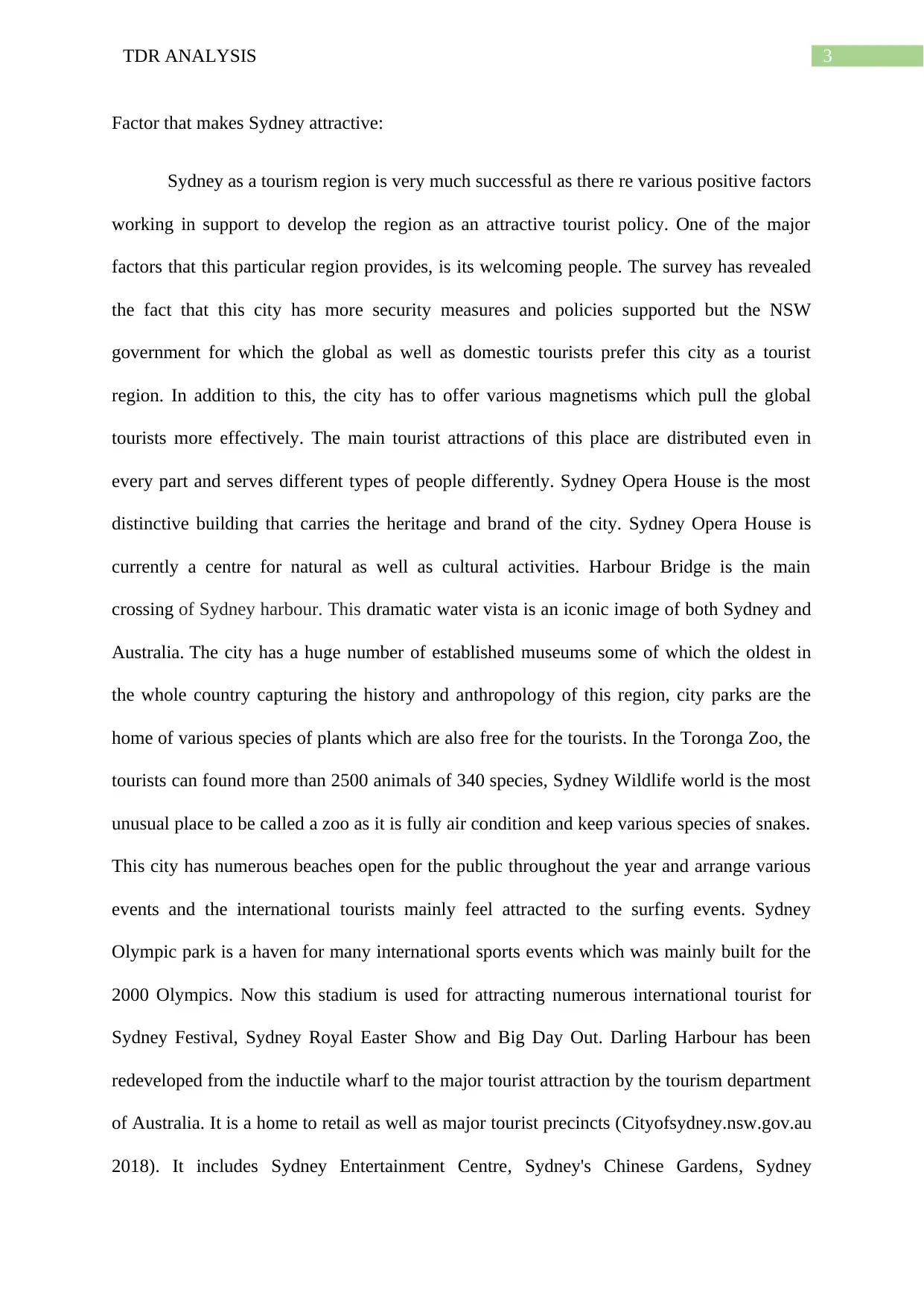
3TDR ANALYSIS
Factor that makes Sydney attractive:
Sydney as a tourism region is very much successful as there re various positive factors
working in support to develop the region as an attractive tourist policy. One of the major
factors that this particular region provides, is its welcoming people. The survey has revealed
the fact that this city has more security measures and policies supported but the NSW
government for which the global as well as domestic tourists prefer this city as a tourist
region. In addition to this, the city has to offer various magnetisms which pull the global
tourists more effectively. The main tourist attractions of this place are distributed even in
every part and serves different types of people differently. Sydney Opera House is the most
distinctive building that carries the heritage and brand of the city. Sydney Opera House is
currently a centre for natural as well as cultural activities. Harbour Bridge is the main
crossing of Sydney harbour. This dramatic water vista is an iconic image of both Sydney and
Australia. The city has a huge number of established museums some of which the oldest in
the whole country capturing the history and anthropology of this region, city parks are the
home of various species of plants which are also free for the tourists. In the Toronga Zoo, the
tourists can found more than 2500 animals of 340 species, Sydney Wildlife world is the most
unusual place to be called a zoo as it is fully air condition and keep various species of snakes.
This city has numerous beaches open for the public throughout the year and arrange various
events and the international tourists mainly feel attracted to the surfing events. Sydney
Olympic park is a haven for many international sports events which was mainly built for the
2000 Olympics. Now this stadium is used for attracting numerous international tourist for
Sydney Festival, Sydney Royal Easter Show and Big Day Out. Darling Harbour has been
redeveloped from the inductile wharf to the major tourist attraction by the tourism department
of Australia. It is a home to retail as well as major tourist precincts (Cityofsydney.nsw.gov.au
2018). It includes Sydney Entertainment Centre, Sydney's Chinese Gardens, Sydney
Factor that makes Sydney attractive:
Sydney as a tourism region is very much successful as there re various positive factors
working in support to develop the region as an attractive tourist policy. One of the major
factors that this particular region provides, is its welcoming people. The survey has revealed
the fact that this city has more security measures and policies supported but the NSW
government for which the global as well as domestic tourists prefer this city as a tourist
region. In addition to this, the city has to offer various magnetisms which pull the global
tourists more effectively. The main tourist attractions of this place are distributed even in
every part and serves different types of people differently. Sydney Opera House is the most
distinctive building that carries the heritage and brand of the city. Sydney Opera House is
currently a centre for natural as well as cultural activities. Harbour Bridge is the main
crossing of Sydney harbour. This dramatic water vista is an iconic image of both Sydney and
Australia. The city has a huge number of established museums some of which the oldest in
the whole country capturing the history and anthropology of this region, city parks are the
home of various species of plants which are also free for the tourists. In the Toronga Zoo, the
tourists can found more than 2500 animals of 340 species, Sydney Wildlife world is the most
unusual place to be called a zoo as it is fully air condition and keep various species of snakes.
This city has numerous beaches open for the public throughout the year and arrange various
events and the international tourists mainly feel attracted to the surfing events. Sydney
Olympic park is a haven for many international sports events which was mainly built for the
2000 Olympics. Now this stadium is used for attracting numerous international tourist for
Sydney Festival, Sydney Royal Easter Show and Big Day Out. Darling Harbour has been
redeveloped from the inductile wharf to the major tourist attraction by the tourism department
of Australia. It is a home to retail as well as major tourist precincts (Cityofsydney.nsw.gov.au
2018). It includes Sydney Entertainment Centre, Sydney's Chinese Gardens, Sydney
Paraphrase This Document
Need a fresh take? Get an instant paraphrase of this document with our AI Paraphraser
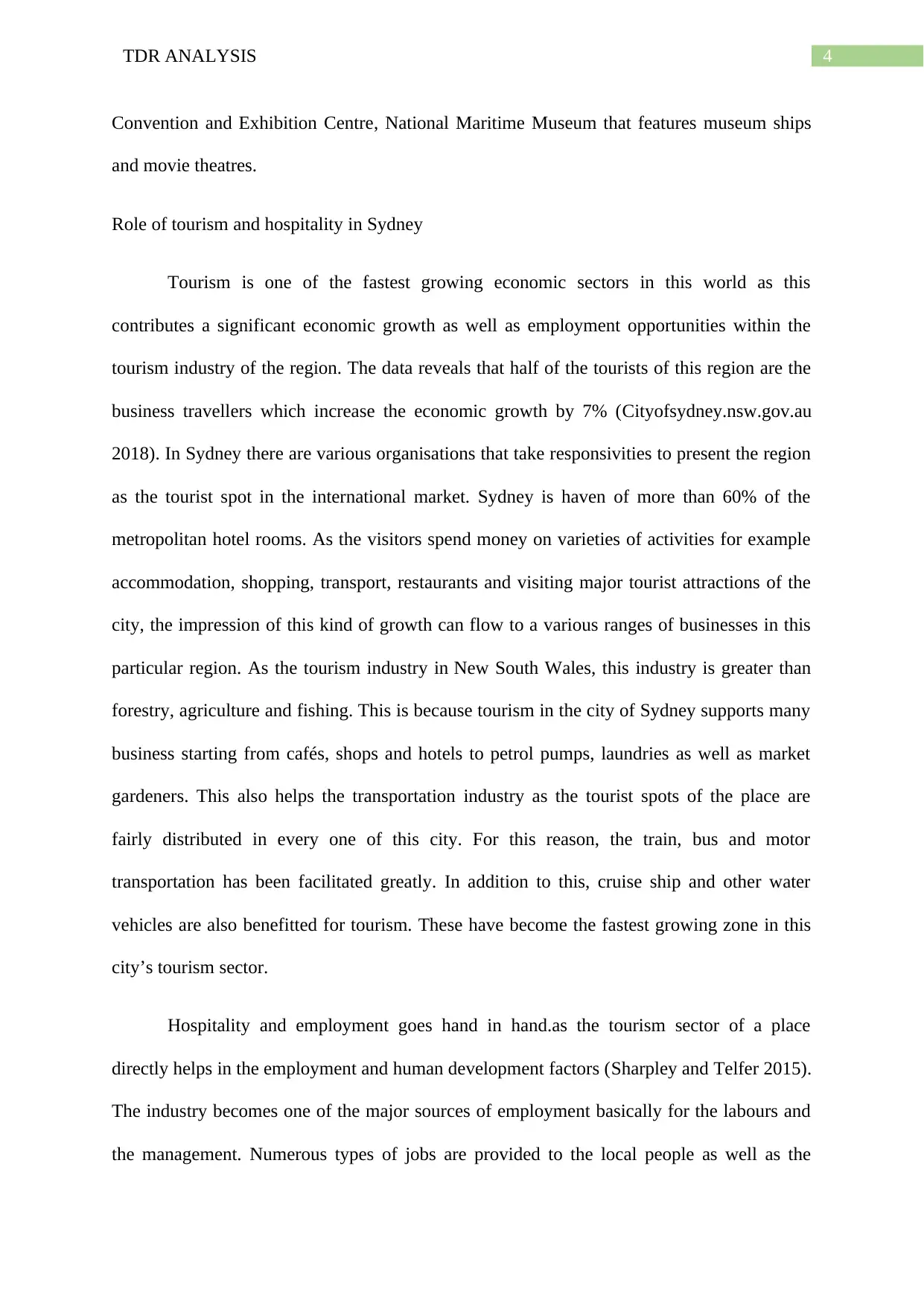
4TDR ANALYSIS
Convention and Exhibition Centre, National Maritime Museum that features museum ships
and movie theatres.
Role of tourism and hospitality in Sydney
Tourism is one of the fastest growing economic sectors in this world as this
contributes a significant economic growth as well as employment opportunities within the
tourism industry of the region. The data reveals that half of the tourists of this region are the
business travellers which increase the economic growth by 7% (Cityofsydney.nsw.gov.au
2018). In Sydney there are various organisations that take responsivities to present the region
as the tourist spot in the international market. Sydney is haven of more than 60% of the
metropolitan hotel rooms. As the visitors spend money on varieties of activities for example
accommodation, shopping, transport, restaurants and visiting major tourist attractions of the
city, the impression of this kind of growth can flow to a various ranges of businesses in this
particular region. As the tourism industry in New South Wales, this industry is greater than
forestry, agriculture and fishing. This is because tourism in the city of Sydney supports many
business starting from cafés, shops and hotels to petrol pumps, laundries as well as market
gardeners. This also helps the transportation industry as the tourist spots of the place are
fairly distributed in every one of this city. For this reason, the train, bus and motor
transportation has been facilitated greatly. In addition to this, cruise ship and other water
vehicles are also benefitted for tourism. These have become the fastest growing zone in this
city’s tourism sector.
Hospitality and employment goes hand in hand.as the tourism sector of a place
directly helps in the employment and human development factors (Sharpley and Telfer 2015).
The industry becomes one of the major sources of employment basically for the labours and
the management. Numerous types of jobs are provided to the local people as well as the
Convention and Exhibition Centre, National Maritime Museum that features museum ships
and movie theatres.
Role of tourism and hospitality in Sydney
Tourism is one of the fastest growing economic sectors in this world as this
contributes a significant economic growth as well as employment opportunities within the
tourism industry of the region. The data reveals that half of the tourists of this region are the
business travellers which increase the economic growth by 7% (Cityofsydney.nsw.gov.au
2018). In Sydney there are various organisations that take responsivities to present the region
as the tourist spot in the international market. Sydney is haven of more than 60% of the
metropolitan hotel rooms. As the visitors spend money on varieties of activities for example
accommodation, shopping, transport, restaurants and visiting major tourist attractions of the
city, the impression of this kind of growth can flow to a various ranges of businesses in this
particular region. As the tourism industry in New South Wales, this industry is greater than
forestry, agriculture and fishing. This is because tourism in the city of Sydney supports many
business starting from cafés, shops and hotels to petrol pumps, laundries as well as market
gardeners. This also helps the transportation industry as the tourist spots of the place are
fairly distributed in every one of this city. For this reason, the train, bus and motor
transportation has been facilitated greatly. In addition to this, cruise ship and other water
vehicles are also benefitted for tourism. These have become the fastest growing zone in this
city’s tourism sector.
Hospitality and employment goes hand in hand.as the tourism sector of a place
directly helps in the employment and human development factors (Sharpley and Telfer 2015).
The industry becomes one of the major sources of employment basically for the labours and
the management. Numerous types of jobs are provided to the local people as well as the
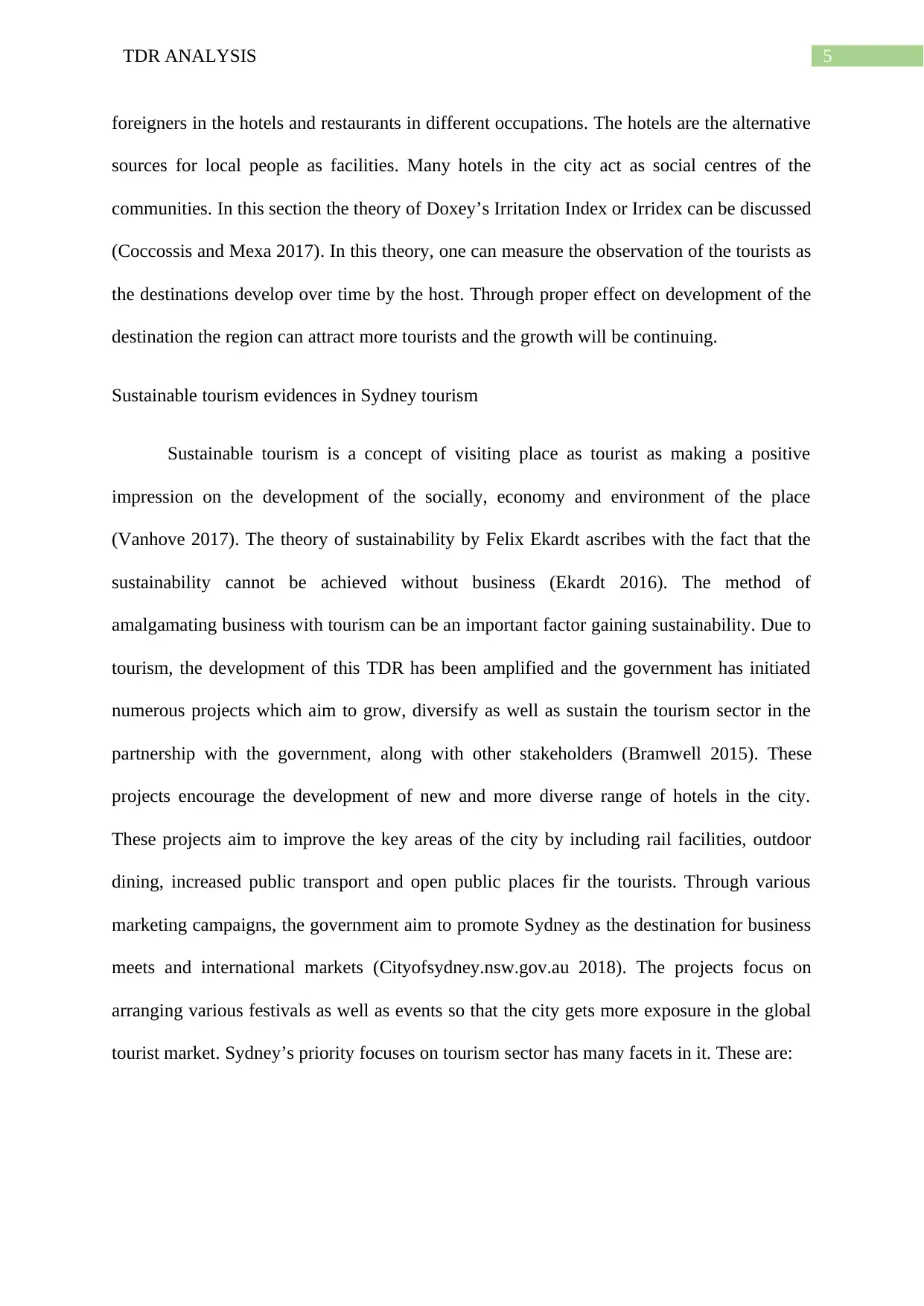
5TDR ANALYSIS
foreigners in the hotels and restaurants in different occupations. The hotels are the alternative
sources for local people as facilities. Many hotels in the city act as social centres of the
communities. In this section the theory of Doxey’s Irritation Index or Irridex can be discussed
(Coccossis and Mexa 2017). In this theory, one can measure the observation of the tourists as
the destinations develop over time by the host. Through proper effect on development of the
destination the region can attract more tourists and the growth will be continuing.
Sustainable tourism evidences in Sydney tourism
Sustainable tourism is a concept of visiting place as tourist as making a positive
impression on the development of the socially, economy and environment of the place
(Vanhove 2017). The theory of sustainability by Felix Ekardt ascribes with the fact that the
sustainability cannot be achieved without business (Ekardt 2016). The method of
amalgamating business with tourism can be an important factor gaining sustainability. Due to
tourism, the development of this TDR has been amplified and the government has initiated
numerous projects which aim to grow, diversify as well as sustain the tourism sector in the
partnership with the government, along with other stakeholders (Bramwell 2015). These
projects encourage the development of new and more diverse range of hotels in the city.
These projects aim to improve the key areas of the city by including rail facilities, outdoor
dining, increased public transport and open public places fir the tourists. Through various
marketing campaigns, the government aim to promote Sydney as the destination for business
meets and international markets (Cityofsydney.nsw.gov.au 2018). The projects focus on
arranging various festivals as well as events so that the city gets more exposure in the global
tourist market. Sydney’s priority focuses on tourism sector has many facets in it. These are:
foreigners in the hotels and restaurants in different occupations. The hotels are the alternative
sources for local people as facilities. Many hotels in the city act as social centres of the
communities. In this section the theory of Doxey’s Irritation Index or Irridex can be discussed
(Coccossis and Mexa 2017). In this theory, one can measure the observation of the tourists as
the destinations develop over time by the host. Through proper effect on development of the
destination the region can attract more tourists and the growth will be continuing.
Sustainable tourism evidences in Sydney tourism
Sustainable tourism is a concept of visiting place as tourist as making a positive
impression on the development of the socially, economy and environment of the place
(Vanhove 2017). The theory of sustainability by Felix Ekardt ascribes with the fact that the
sustainability cannot be achieved without business (Ekardt 2016). The method of
amalgamating business with tourism can be an important factor gaining sustainability. Due to
tourism, the development of this TDR has been amplified and the government has initiated
numerous projects which aim to grow, diversify as well as sustain the tourism sector in the
partnership with the government, along with other stakeholders (Bramwell 2015). These
projects encourage the development of new and more diverse range of hotels in the city.
These projects aim to improve the key areas of the city by including rail facilities, outdoor
dining, increased public transport and open public places fir the tourists. Through various
marketing campaigns, the government aim to promote Sydney as the destination for business
meets and international markets (Cityofsydney.nsw.gov.au 2018). The projects focus on
arranging various festivals as well as events so that the city gets more exposure in the global
tourist market. Sydney’s priority focuses on tourism sector has many facets in it. These are:
⊘ This is a preview!⊘
Do you want full access?
Subscribe today to unlock all pages.

Trusted by 1+ million students worldwide
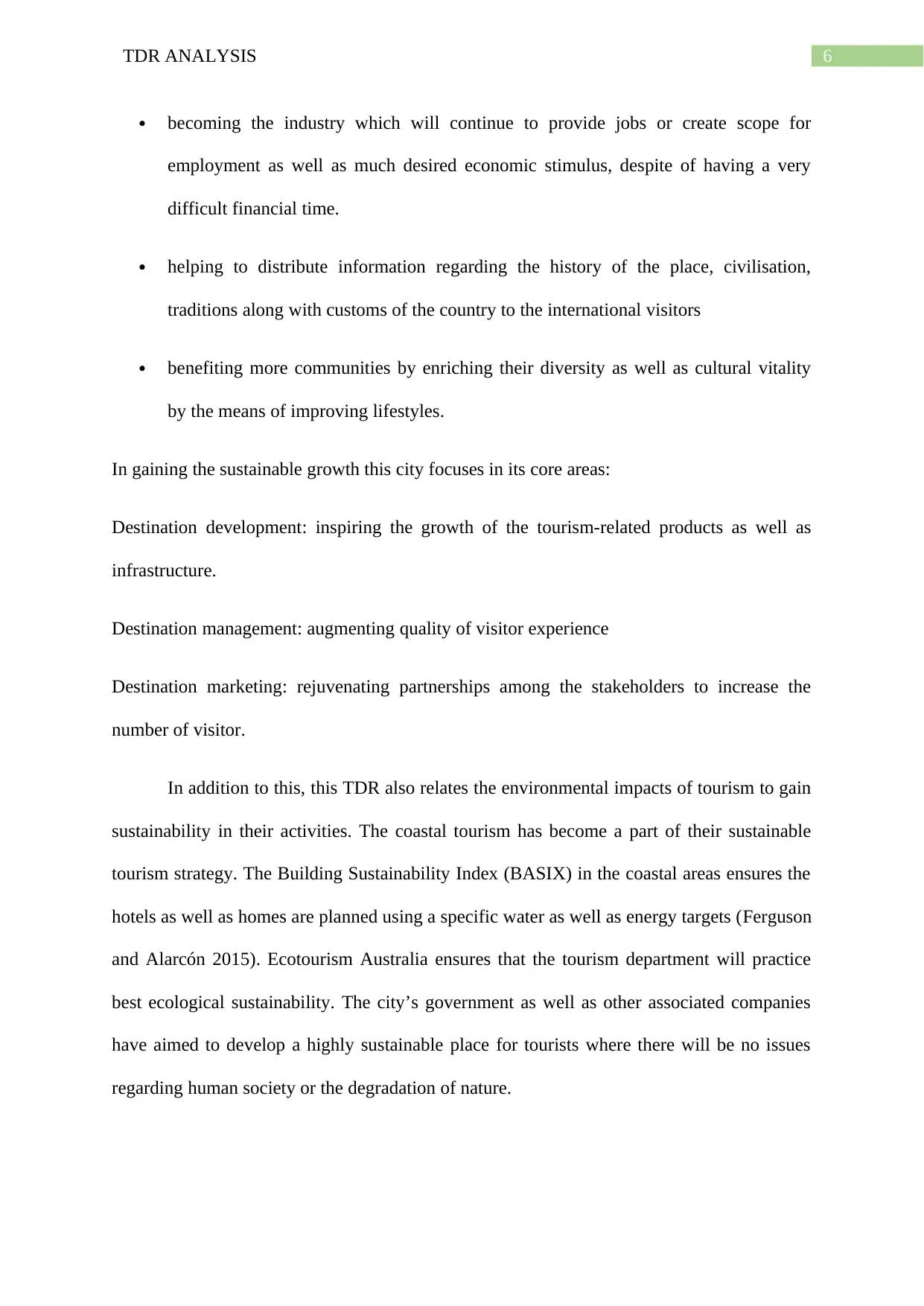
6TDR ANALYSIS
becoming the industry which will continue to provide jobs or create scope for
employment as well as much desired economic stimulus, despite of having a very
difficult financial time.
helping to distribute information regarding the history of the place, civilisation,
traditions along with customs of the country to the international visitors
benefiting more communities by enriching their diversity as well as cultural vitality
by the means of improving lifestyles.
In gaining the sustainable growth this city focuses in its core areas:
Destination development: inspiring the growth of the tourism-related products as well as
infrastructure.
Destination management: augmenting quality of visitor experience
Destination marketing: rejuvenating partnerships among the stakeholders to increase the
number of visitor.
In addition to this, this TDR also relates the environmental impacts of tourism to gain
sustainability in their activities. The coastal tourism has become a part of their sustainable
tourism strategy. The Building Sustainability Index (BASIX) in the coastal areas ensures the
hotels as well as homes are planned using a specific water as well as energy targets (Ferguson
and Alarcón 2015). Ecotourism Australia ensures that the tourism department will practice
best ecological sustainability. The city’s government as well as other associated companies
have aimed to develop a highly sustainable place for tourists where there will be no issues
regarding human society or the degradation of nature.
becoming the industry which will continue to provide jobs or create scope for
employment as well as much desired economic stimulus, despite of having a very
difficult financial time.
helping to distribute information regarding the history of the place, civilisation,
traditions along with customs of the country to the international visitors
benefiting more communities by enriching their diversity as well as cultural vitality
by the means of improving lifestyles.
In gaining the sustainable growth this city focuses in its core areas:
Destination development: inspiring the growth of the tourism-related products as well as
infrastructure.
Destination management: augmenting quality of visitor experience
Destination marketing: rejuvenating partnerships among the stakeholders to increase the
number of visitor.
In addition to this, this TDR also relates the environmental impacts of tourism to gain
sustainability in their activities. The coastal tourism has become a part of their sustainable
tourism strategy. The Building Sustainability Index (BASIX) in the coastal areas ensures the
hotels as well as homes are planned using a specific water as well as energy targets (Ferguson
and Alarcón 2015). Ecotourism Australia ensures that the tourism department will practice
best ecological sustainability. The city’s government as well as other associated companies
have aimed to develop a highly sustainable place for tourists where there will be no issues
regarding human society or the degradation of nature.
Paraphrase This Document
Need a fresh take? Get an instant paraphrase of this document with our AI Paraphraser

7TDR ANALYSIS
Therefore, it can be concluded that the TDR is an important part of tourism
development of the place. Here in this essay TDR has been taken as Sydney, one of the
largest city of Australia. This has become one of the major region of tourist attraction due to
its natural beauty, national importance and business presence. The region has developed itself
with the support of the government of NSW which provides financial as well as
administrative support for developing an attractive place for the visits of domestic as well as
international tourists. The government along with other organisations have built the
arrangements of accommodation, transportation and other facilities which has helped rhea
industry in one hand and receive benefits due to this industry effectively. The issue of
sustainable development has gained importance in this place so that the region continues to
flourish with time.
Therefore, it can be concluded that the TDR is an important part of tourism
development of the place. Here in this essay TDR has been taken as Sydney, one of the
largest city of Australia. This has become one of the major region of tourist attraction due to
its natural beauty, national importance and business presence. The region has developed itself
with the support of the government of NSW which provides financial as well as
administrative support for developing an attractive place for the visits of domestic as well as
international tourists. The government along with other organisations have built the
arrangements of accommodation, transportation and other facilities which has helped rhea
industry in one hand and receive benefits due to this industry effectively. The issue of
sustainable development has gained importance in this place so that the region continues to
flourish with time.

8TDR ANALYSIS
References:
Bramwell, B., 2015. Theoretical activity in sustainable tourism research. Annals of Tourism
Research, 54, pp.204-218.
Butler, R. ed., 2006. The tourism area life cycle (Vol. 1). Channel view publications.
Cityofsydney.nsw.gov.au (2018). Tourism - City of Sydney. [online]
Cityofsydney.nsw.gov.au. Available at:
http://www.cityofsydney.nsw.gov.au/business/business-support/business-in-your-sector/key-
industries/tourism [Accessed 24 May 2018].
Coccossis, H. and Mexa, A., 2017. The challenge of tourism carrying capacity assessment:
Theory and practice. Routledge.
de Grosbois, D., 2016. Corporate social responsibility reporting in the cruise tourism
industry: A performance evaluation using a new institutional theory based model. Journal of
Sustainable Tourism, 24(2), pp.245-269.
Ekardt, F., 2016. Justice and Sustainability: Normative Criteria for the Use of Phosphorus.
In Phosphorus in Agriculture: 100% Zero (pp. 317-330). Springer, Dordrecht.
Ferguson, L. and Alarcón, D.M., 2015. Gender and sustainable tourism: reflections on theory
and practice. Journal of Sustainable Tourism, 23(3), pp.401-416.
Leiper, N., 1990. Tourist attraction systems. Annals of tourism research, 17(3), pp.367-384.
Sharpley, R. and Telfer, D.J., 2015. Tourism and development in the developing world.
Routledge.
Stergiou, D.P. and Airey, D., 2018. Understandings of tourism theory. Tourism Review.
References:
Bramwell, B., 2015. Theoretical activity in sustainable tourism research. Annals of Tourism
Research, 54, pp.204-218.
Butler, R. ed., 2006. The tourism area life cycle (Vol. 1). Channel view publications.
Cityofsydney.nsw.gov.au (2018). Tourism - City of Sydney. [online]
Cityofsydney.nsw.gov.au. Available at:
http://www.cityofsydney.nsw.gov.au/business/business-support/business-in-your-sector/key-
industries/tourism [Accessed 24 May 2018].
Coccossis, H. and Mexa, A., 2017. The challenge of tourism carrying capacity assessment:
Theory and practice. Routledge.
de Grosbois, D., 2016. Corporate social responsibility reporting in the cruise tourism
industry: A performance evaluation using a new institutional theory based model. Journal of
Sustainable Tourism, 24(2), pp.245-269.
Ekardt, F., 2016. Justice and Sustainability: Normative Criteria for the Use of Phosphorus.
In Phosphorus in Agriculture: 100% Zero (pp. 317-330). Springer, Dordrecht.
Ferguson, L. and Alarcón, D.M., 2015. Gender and sustainable tourism: reflections on theory
and practice. Journal of Sustainable Tourism, 23(3), pp.401-416.
Leiper, N., 1990. Tourist attraction systems. Annals of tourism research, 17(3), pp.367-384.
Sharpley, R. and Telfer, D.J., 2015. Tourism and development in the developing world.
Routledge.
Stergiou, D.P. and Airey, D., 2018. Understandings of tourism theory. Tourism Review.
⊘ This is a preview!⊘
Do you want full access?
Subscribe today to unlock all pages.

Trusted by 1+ million students worldwide

9TDR ANALYSIS
Vanhove, N., 2017. The Economics of Tourism Destinations: Theory and Practice.
Routledge.
Vanhove, N., 2017. The Economics of Tourism Destinations: Theory and Practice.
Routledge.
1 out of 10
Related Documents
Your All-in-One AI-Powered Toolkit for Academic Success.
+13062052269
info@desklib.com
Available 24*7 on WhatsApp / Email
![[object Object]](/_next/static/media/star-bottom.7253800d.svg)
Unlock your academic potential
Copyright © 2020–2025 A2Z Services. All Rights Reserved. Developed and managed by ZUCOL.





